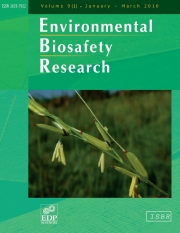Article contents
Spider web survey or whole plant visual sampling?Impact assessment of Bt corn on non-target predatory insects with two concurrent methods
Published online by Cambridge University Press: 15 June 2005
Abstract
Impact assessment studies rely on relevant sampling methods. Correct evaluation of methods can be done by their concurrent use in the same sampling site and period. Collecting webs of Theridion impressum L. Koch (Araneae: Theridiidae) may serve as an arthropod sampling method: empty cuticles of prey items remain attached to the back side of the leaves with adhesive silk. Our study aimed to compare the applicability of the two methods concurrently (spider web survey and whole plant visual sampling) in a risk assessment study. The spider web survey recorded more predatory insect families than the whole plant visual sampling. Both methods were able to detect significant differences in the quantity of predatory insects in Bt vs. isogenic plots, but not in the same taxa (Nabidae: spider-web, 2001, Bt > Iso; Coccinellidae: plant sampling, 2001, Iso > Bt; Welsh-test, P < 0.05); thus, they could not confirm each other. The lack of confirmation can be explained by differences in the sensitivity and selectivity of the two methods. A web survey of T. impressum has the practical advantage that although we concentrate only on the one species during field sampling, we gain additional information on a wide range of foliage-dwelling arthropods. Due to several biological uncertainties, interpretation and explanation of the results remain problematic. Thus, additional research – based on in-situ observation and recording of T. impressum-prey interactions – is necessary before we could propose web survey method as a complementary tool in ecological impact assessment.
Keywords
- Type
- Research Article
- Information
- Copyright
- © ISBR, EDP Sciences, 2004
References
- 5
- Cited by


